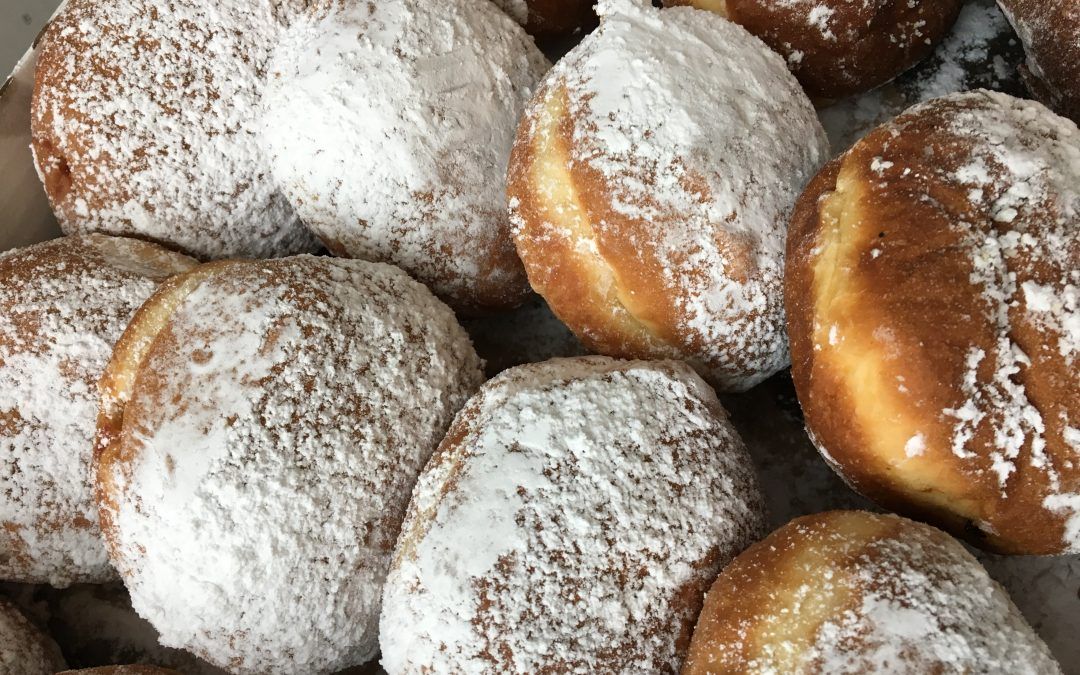These days, Fat Thursday is a holiday centered on food. Although the prototypes of today’s doughnuts were filled with pork fat, today we eat sweets. Historically, the holiday heralded the pompous end of Carnival, which we still celebrate today, although probably with less pomp and differently. Today, on Fat Thursday in Eximius Park, we bring you closer to the history of the doughnut!
Pork fat and jam
Have you ever wondered why Fat Thursday is called fat, when we commonly eat sweet doughnuts and fritters (so-called “angel wings”) on this day? The name does not refer only to the fat, in which the dough filled with sweet filling is fried. In the old Polish tradition, Shrovetide, as well as the entire carnival, was based on fatty foods, which were eaten as if to stock up. The fast that followed the carnival was characterized by strict prohibitions on eating meat and all fat. For this reason, at the end of the carnival, doughnuts filled with pork fat were made, as well as other wheat pastries served with plenty of fat. Sweet doughnuts first appeared on the tables of the nobility and the bourgeoisie in the 16th century. They were most probably borrowed from Arabian cuisine, although their roots can be found even in ancient Rome. Before they were stuffed with jam, they more often contained nuts or almonds.
International roots
There are several legends explaining the origin of the donut as a balls-shaped dessert. One of them tells of a German confectioner who wanted to serve in the imperial army, but was only recruited into the military kitchen due to his fragile health. Apparently, out of joy that his dream had at least partially come true, he invented a snack in the shape of a cannonball. According to Austrian legend, the doughnut owes its origins to 17th-century Viennese confectioner Cecilia Krapf. The new pastry was supposedly discovered during a marital quarrel when the pastry shop owner threw dough at her husband, and it accidentally fell into the heated fat. In another version, legend has it that Mrs Cecylia fed doughnuts to the defenders of Vienna during a Turkish siege. In Poland, Mikołaj Rej wrote about the ancestors of donuts, calling them “kreple”. Further reports are known from old cookery books, e.g. from the Radziwiłłs’ court. Although the recipe came from a different culinary tradition, it is still very popular in Poland today.
Similar customs
In Poland, we celebrate on Thursday, but in the UK and France, the tradition falls on the last Tuesday before Ash Wednesday. It’s called Pancake Tuesday in UK, and Mardi Gras in France, and in both countries sweet pancakes are the most popular snack on that day. The French do not stop at just one treat, waffles, fritters and doughnuts are also popular. What is more, there are lavish parades and festivals. Scandinavians celebrate on the last Sunday of the carnival and on this day, children come to school exceptionally to celebrate this sweet day with fun and costumes. In our western neighbours, on Schmotziger Donnerstag, doughnuts (German: krapfen) are eaten in various versions, but the tradition of colourful, costumes parades is just as lively. The Russians extend Shrovetide (ro. Maselnica) for a whole week, 7 weeks before Easter.
100 million doughnuts
To avoid currently unnecessary queues and crowds in patisseries, this year a doughnut can even be ordered with delivery to your home or office, using the offer of catering companies and food ordering applications. Due to the increase in awareness and popularity of healthy eating, the consumption of bakery products has been decreasing for several years. According to data from Central Statistical Office, in 2019 we ate 2.98 kg of bakery products per person per month, compared to 3.15 kg in 2018 and as recently as 2014. 3.94kg. However, it is estimated that this year on Fat Thursday Poles will eat around 100 million doughnuts, or an average of 2.5 pieces per person. Perhaps the popularity of these fried sweets is related to an old superstition which says that whoever does not eat a doughnut on Fat Thursday will not be lucky throughout the year.
Have a sweet day!


